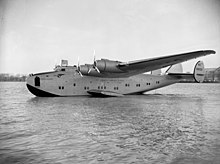Lisbon-Cabo Ruivo Airport
| Lisbon-Cabo Ruivo Airport (Aeroporto Marítimo de Cabo Ruivo) | ||
|---|---|---|
|
|
||
| Characteristics | ||
| Coordinates | ||
| Height above MSL | 0 m (0 ft ) | |
| Basic data | ||
| opening | 1939 | |
The Cabo Ruivo Seaplane Base ( port. : Aeroporto Marítimo de Cabo Ruivo ) was an international commercial airport for seaplanes in the Portuguese capital Lisbon .
history
In the 1930s, the Portuguese government decided to replace the Campo Internacional de Aterragem airport near Alverca with two new airports closer to Lisbon: today's Aeroporto da Portela and on the Tagus River the Aeroporto Marítimo de Cabo Ruivo , from which transatlantic flights are available should be handled in seaplanes. Both airports were built at the same time from 1938 and completed in 1939/1940. The Aeroporto Marítimo de Cabo Ruivo was on the right bank of the Tagus at the Doca dos Olivais dock . A fast car connection, today's Avenida de Berlim, was built between them.
The US intercontinental airline Pan American World Airways, which played a key role in building the airport, served it as a hub for its transatlantic flights until 1945.
The first commercial flight landed on June 29, 1939 at the seaplane base of the Aeroporto Marítimo de Cabo Ruivo. This Atlantic flight from New York to Lisbon was carried out with a Boeing 314 "Yankee Clipper" (registration number: NC 18603) of the airline Pan American World Airways with 22 passengers and 12 crew members on board.
On February 22nd, 1943, this Pan American World Airways aircraft was destroyed in an accident in the Tejo Bay near Aeroporto Marítimo during a ditching maneuver. 24 of the 39 inmates were killed.
With the enormous increase in the importance of terrestrial air traffic, the era of seaplanes came to an end. Cabo Ruivo Airport was closed at the end of 1958 after the British Aquila Airways on September 30, 1958 and the Portuguese ARTOP Linhas Aéreas on November 12, 1958, were the last local companies to cease operations. The airport site was further developed as part of the Expo 98 world exhibition . Today there is the Parque das Nações (Park of Nations) with the Oceanário de Lisboa (Oceanarium).
Web links
- On the history of the airport (PDF file; 604 kB) from the Associação Náutica da Marina do Parque das Nações (Portuguese)
- Weblog with pictures from the time of flight operations (Portuguese)
- Map of the airport

